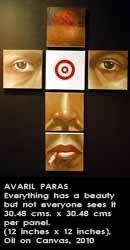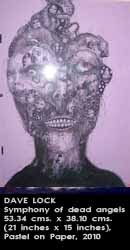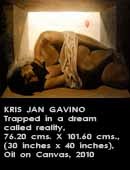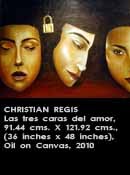Sining Amang is composed of Eldrid Ayende, Garry Cruz, Artemio Conde, Michael Toribio and Brian Villareal. All of which are Fine Arts students at EARIST (Eulogio Amang Rodriguez Institute of Science and Technology). Surprisingly, they weren’t all in the same batch, they would later meet years after. They met each other by different means, and they bonded by their artistic goal for art exhibitions. They claim that Sigwada Gallery was one of the key elements that strengthen their bond. And where else should their first group show be?
Singkong Saloobin is a look within your kept emotions and ideals. It is a peek at one’s personal secret diary and exposing it to the public, but not with trembling hands, but with slid strokes and determined objectives to show the world who they really are, what they really want to say and what they really want us to see.
The group talks about death, faith and losing faith, fears and misconceptions, love and heartaches, deceit. The group explains that these are experiences they have endured, these are lessons they wish for their viewers to learn. Yes, it’s mostly a cauldron filled with negativity, at first glance maybe. But if you look again, dig deeper, there’s another part of the story in which they tell on the canvas. All the negativity in the world can and has a positive thing in it. And that is the lesson learned afterwards. The moral in the story, the lesson in the mistake, the shining moment out of darkness, and these artists are the living proof.
Eldrid Ayende’s work entitled, “Wala sa Realidad and Kahulugan ng Tunay na Katahimikan” talks about how one’s faith can deteriorate in time. How one’s experience can easily make you abandon your faith. He expresses his thought on his painting by depicting the statue of a saint and how, because it is wooden, being eaten slowly by termites. The deterioration and having not to care for the statues symbolizes how one cannot sustain faith. One simply forgets it. Though the lesson Eldrid explains is that, even though a/the statue crumbles down in the physical world, it doesn’t or it shouldn’t affect one’s faith.
Garry Cruz’s “Nasobrahan sa Love” explains that too much of everything is not good for you, not good for anyone. It tackles the self destruction of a man whose main goal was to love but in the end found the opposite. Based on experience, Gary described his work as a very personal work, close to being a journal and at the same time a rant or his emotions, but non-the-less a lesson to others who have yet to trail the path of giving and taking too much love.
Artemio Conde explains that after one’s death, the grudges and negativity we used to see and have for a person should be buried along in the grave in his work, “All that Remains” Artemio further reached out to his core and explained that these are topics that he can’t normal say to people surrounding him, that these are the things that he sees as a solution. When a person leaves this word, like in a eulogy, we instead remember them with the moments that we cherish, because basically, he says, that is all that really remains.
Michael Toribio’s “Death + Hourgalss” is basically a cycle of life and death. It is his expression of the reality of things to come and of where things start. Michael wants to remind his audience no to prepare, but to brace themselves and accept the fact of one’s death and it is a part of life. The idea is not all peaches and rainbows, but the message is that of an hourglass, after the last grain of salt falls rebirth comes when it is switched backed on the other side.
Brian Villareal has lived through the street of Quiapo, Manila most of his adult life, when he passes by the underpass or the church of Quiapo, along with people come children begging for alms. In his work, “Palimos ang Paawang Pulubi” he portrays a boy he has seen a few times, have observed more than once that the change gives to him by passer bys doesn’t have a higher goal than to sustain addiction. Weather it’s computer games or rugby in the nearby hardware store, it doesn’t go farther that that. Brian’s painting depicts the boy with a sad face, almost crying, begging. But all the while when you look closely a different message can be seen. The intentions of the young man revealed, and the piece talks to the audience, telling them that the young man only wants money, but needs love instead to change his life.
Madness fills the world with what a person perceives, darkness fills the streets of Manila right after the sun sets. People sleep and some people reveal their dark side in the night. Instead of cowering in the dark, people can overcome it. Survive in it. After all the sun comes out tomorrow and gives us a new day, but with lessons learned after the night, we can act differently, forever adjusting, forever changing until we finally get it right.
They face their fears and send out their messages through art. Artists who have similar goals have done the same, yes, it’s nothing new. What’s new is this group’s voice. It’s not the first time these artists have gathered to participate in a group show. It’s their voice in unity that echoes throughout, and that makes it unique. It’s the voice that shouts out and at the same time whispers it in their canvas.
Their message is simple, words aren’t the only way to bring about your feelings and emotions, actions of course speak louder, but this is their approach. It is their lessons learned, their experiences, and their perspective on how one or a group of five can be heard and listened to even without words.
Texts: Marius Black


























